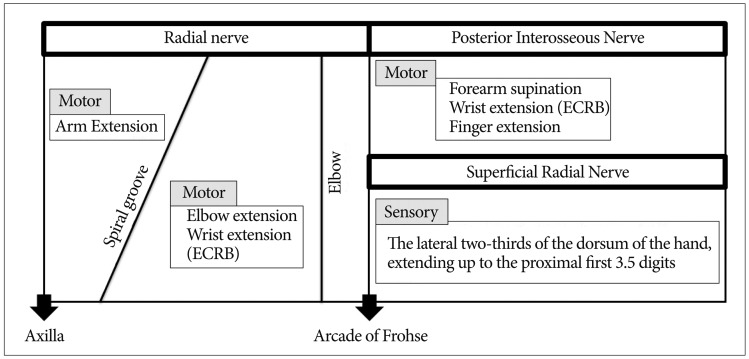J Korean Neurosurg Soc.
2014 Mar;55(3):148-151. 10.3340/jkns.2014.55.3.148.
Clinical Features of Wrist Drop Caused by Compressive Radial Neuropathy and Its Anatomical Considerations
- Affiliations
-
- 1Department of Neurosurgery, Chuncheon Sacred Heart Hospital, College of Medicine, Hallym University, Chuncheon, Korea. nssur771@hallym.or.kr
- KMID: 2191080
- DOI: http://doi.org/10.3340/jkns.2014.55.3.148
Abstract
OBJECTIVE
Posture-induced radial neuropathy, known as Saturday night palsy, occurs because of compression of the radial nerve. The clinical symptoms of radial neuropathy are similar to stroke or a herniated cervical disk, which makes it difficult to diagnose and sometimes leads to inappropriate evaluations. The purpose of our study was to establish the clinical characteristics and diagnostic assessment of compressive radial neuropathy.
METHODS
Retrospectively, we reviewed neurophysiologic studies on 25 patients diagnosed with radial nerve palsy, who experienced wrist drop after maintaining a certain posture for an extended period. The neurologic presentations, clinical prognosis, and electrophysiology of the patients were obtained from medical records.
RESULTS
Subjects were 19 males and 6 females. The median age at diagnosis was 46 years. The right arm was affected in 13 patients and the left arm in 12 patients. The condition was induced by sleeping with the arms hanging over the armrest of a chair because of drunkenness, sleeping while bending the arm under the pillow, during drinking, and unknown. The most common clinical presentation was a wrist drop and paresthesia on the dorsum of the 1st to 3rd fingers. Improvement began after a mean of 2.4 weeks. Electrophysiologic evaluation was performed after 2 weeks that revealed delayed nerve conduction velocity in all patients.
CONCLUSION
Wrist drop is an entrapment syndrome that has a good prognosis within several weeks. Awareness of its clinical characteristics and diagnostic assessment methods may help clinicians make diagnosis of radial neuropathy and exclude irrelevant evaluations.
Keyword
MeSH Terms
Figure
Reference
-
1. Arnold WD, Krishna VR, Freimer M, Kissel JT, Elsheikh B. Prognosis of acute compressive radial neuropathy. Muscle Nerve. 2012; 45:893–895. PMID: 22581545.
Article3. Bsteh G, Wanschitz JV, Gruber H, Seppi K, Löscher WN. Prognosis and prognostic factors in non-traumatic acute-onset compressive mononeuropathies - radial and peroneal mononeuropathies. Eur J Neurol. 2013; 20:981–985. PMID: 23530751.
Article4. Düz B, Solmaz I, Civelek E, Onal MB, Pusat S, Daneyemez M. Analysis of proximal radial nerve injury in the arm. Neurol India. 2010; 58:230–234. PMID: 20508341.
Article5. Hermansdorfer JD, Greider JL, Dell PC. A case report of a compressive neuropathy of the radial sensory nerve caused by a ganglion cyst at the elbow. Orthopedics. 1986; 9:1005–1006. PMID: 3748899.
Article6. Jou IM, Wang HN, Wang PH, Yong IS, Su WR. Compression of the radial nerve at the elbow by a ganglion : two case reports. J Med Case Rep. 2009; 3:7258. PMID: 19830153.
Article7. Khodulev VI, Nechipurenko NI, Antonov IP, Arkind GD. [The electroneuromyographic study of the radial nerve : compressive ischemic neuropathy of the posterior interosseous nerve]. Zh Nevrol Psikhiatr Im S S Korsakova. 2008; 108:48–55. PMID: 18833118.8. Kimbrough DA, Mehta K, Wissman RD. Case of the season : Saturday Night Palsy. Semin Roentgenol. 2013; 48:108–110. PMID: 23452458.9. Kirici Y, Irmak MK. Investigation of two possible compression sites of the deep branch of the radial nerve and nerve supply of the extensor carpi radialis brevis muscle. Neurol Med Chir (Tokyo). 2004; 44:14–18. discussion 19PMID: 14959931.
Article
- Full Text Links
- Actions
-
Cited
- CITED
-
- Close
- Share
- Similar articles
-
- Compressive Radial Neuropathy Developed Under a Fibrotic Band Associated With Rhabdomyolysis and Successfully Treated With Surgery
- Radial Neuropathy after Cryolipolysis
- Superficial Radial Neuropathy due to Anatomic Variation: A Case Report
- Ipsilateral Radial Neuropathy after COVID-19 mRNA Vaccination in an Immunocompetent Young Man
- The Usefulness of Proximal Radial Motor Conduction in Acute Compressive Radial Neuropathy



